THE PALPA MOUNTAIN INSCRIPTION
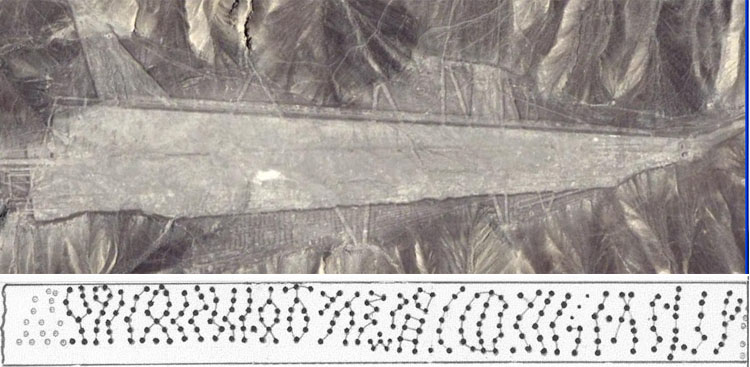
Further very compelling proof that the Nazca line builders
had come from homelands in the Mediterranean is provided by a huge inscription,
in Phoenician writing, spelt out by stone heaps. The site where it is found
is at Palpa Mountain, about 9-miles (14.5-kilometres) NNW of where the main
body of Nazca desert geometry commences. The huge inscription is described
in archaeological literature as 300-metres long and 20 metres wide and says:
Dr Winters transliteration:
Come down [into
the earth] and spread this. Strain and pacify the water [in
the area]
Come and spread [within this region].
Grace. Go out [among the land]
and become strong.
Dr Winters further commented: “It would be interesting
if this area was settled in the past and provided arable land and water for
the ancient farmers”.
This, of course, occurred and in the Nazca region further south alone, over
93-miles (150-kilometers) of mostly subterranean aqueducts (aquifiers) had
to be dug, along with multiple filtration galleries and their associated "puquios"
(wells). These ancient works are the only reason the region is habitable today.
Some Internet commentary on the origins of the Phoenician
script:
According to the ancient Greek historian,
Herodotus, the Phoenicians introduced their alphabet to Greece. Cadmus the
Phoenician is attributed with the credit for this introduction. Further, Phoenician
trade was the vessel which speeded the spread of this alphabet along side
Phoenician trade which went to the far corners of the Mediterranean. Phoenician
alphabet is the ancestor of the Greek alphabet and, hence, of all Western
alphabets. The earliest Phoenician inscription that has survived is the Ahiram
epitaph at Byblos in Phoenicia, dating from the 11th century BC and written
in the North Semitic alphabet. The Phoenician alphabet gradually developed
from this North Semitic prototype and was in use until about the 1st century
BC in Phoenicia proper. Phoenician colonial scripts, variants of the mainland
Phoenician alphabet, are classified as Cypro-Phoenician (10th-2nd century
BC) and Sardinian (c. 9th century BC) varieties. A third variety of the colonial
Phoenician script evolved into the Punic and neo-Punic alphabets of Carthage,
which continued to be written until about the 3rd century AD. Punic was a
monumental script and neo-Punic a cursive form.
There is considerable confusion these
days concerning just who the seafaring Phoenicians were,
inasmuch as they ranged from Byblos, Sidon & Tyre, in Lebanon (formerly
Israel or Canaan) and that region has undergone multiple conquests and occupations
since 750 BC. In the earliest years and through their "golden-age"
of shipping goods around the Mediterranean or trading, mining and setting
up colonial outposts far afield, the Phoenicians were Hebrews.
One of the great historical mistakes that
is perpetuated today is to call the Hebrew people "Jewish". The
fact of the matter is that the vast majority of people who today call themselves
Jewish have no traceable ethnic links to the Hebrew-Phoenicians mother country
and none to the Hebrew-Phoenicians themselves. Jewish people (over 92%) are
ethnic Khazars (Ashkenazi) whose lands of origin were around the Ukraine of
Russia (over a thousand miles northwards of Israel-Phoenicia). Prior to that
the Khazars had migrated into Eastern Europe from Mongolia. They are a people
who adopted the Babylonian Talmudic-Pharasee religion in the 8th century AD,
around 1700-years after the Hebrew-Israelite-Phoenician "golden age".
The vast majority of Jewish people are
not even of "Semitic" origin, but have only adopted one of the Semitic
religions (a late era Babylonian-Pharassee form). Even the very small percentage
of Sephardim-Babylonian-Jewish people (Sephardim means Spanish) stem from
a period of about 1000-years after the Hebrew-Phoenician "golden age".
They were Babylonian refugees who fled from the Romans in about 70 AD and
have some ethnic roots going back to the Babylonian conquerors who defeated
the last Hebrew kingdom. The Semitic Babylonians occupied Israel from 586
BC until their own expulsion under the Roman general Titus. One Jewish Rabbi
historian commented: "The era of the Hebrews ended when the era
of the Jews began". The statement is only partially correct,
inasmuch as it can only encompass the very small percentage of so-called Sephardim-Jewish
people of today, whose ancestry can be traced back to the Babylonian refugees
who fled from the Romans to Spain or to other countries like Ethiopia around
70 AD.
The term "Jewish" seems to be
loosely based upon "Judeans" or people from the land called "Judea"...
the former Southern Kingdom of the Hebrew or Israelite tribe of "Judah".
Neither the Ashkenazi Turko-Khazzar Jewish people nor the Babylonian Sephardim
Jewish people have any links to the Semitic Hebrew-Phoenician-Israelites.
The actual Hebrew-Phoenician refugee survivors
fled from Israel-Lebanon between the 8th century BC to the 6th century BC,
as their kingdoms and fortress cities fell to Assyrian, and later, Babylonian
invaders. Most sought sanctuary amongst their cousins in Continental Europe,
with many going to Britain, Greece, Corsica, Sardinia, or Sicily after escaping,
firstly, to Egypt. Many gained sanctuary at colonial outposts like Carthage
and remained there until losing it and other Mediterranean Islands to the
Romans during the "Punic wars" (Punic is the latin
word for Phoenician and Carthage was, by the time of the
Punic wars in 264 BC, a Greco-Phoenician confederation).
It must be remembered that the Hebrew-Phoenicians
had tin mines in Cornwall, England from at least 1300 BC and copper mines
in Cyprus (the Phoenician name for England was "Cassiderites" or
"Tin Island" and "Cyprus" means "Copper"). Continued
access to tin was highly important to ancient Mediterranean nations, as it
was an essential ingredient in the fabrication of bronze weapons or other
important utensils. An historical fact, which is emerging very strongly accompanied
by indisputable archaeological and geographical evidence, is that ancient
Troy was situated on the Gog
Magog hills of Cambridgeshire in England and that the Trojan War was fought
between Celtic nations, primarily over access or ownership of British tin
resources. For a profound study on the true setting for events described in
Homer's Iliad CLICK
HERE
The Hebrew-Phoenicians also had very rich
silver mines at Rio Tinto in the region of Huelva, southwestern Spain. An
early era name for Spain was Iberia, which means "Hebrews". Further
strong evidence shows that the Phoenicians had mining operations at Sarina
Beach in Western Australia, where iron and other metals, scarce in the Mediterranean,
were plentiful and the ore very rich in metal content. Gold was plentiful
in the Americas and would have been a strong enticement to sail to that region.
We know that ancient mariners were bringing South American tobacco and cocaine
from Bolivia / Peru to the Egyptians, as these substances have been positively
detected in Egyptian mummies
CLICK HERE
There is also compelling evidence to show
that the early Hebrew-Phoenicians were ranging to the northern shore of Lake
Superior in Canada to mine copper, which, it appears, was later refine-smelted
at Enzion-Geber of Southern Israel. Sophisticated blast furnaces, exploiting
the strong, steady winds blowing up the Gulf of Aqaba, were in operation around
1000 BC and the slag heaps, left over from the smelting and purifying, remain.
It is estimated that 500,000,000 pounds of copper was removed from northern
Lake Superior, none of which remained in the Americas (See: The
Lost Ten Tribes of Israel Found, by Stephen M Collins, pp. 26-28).
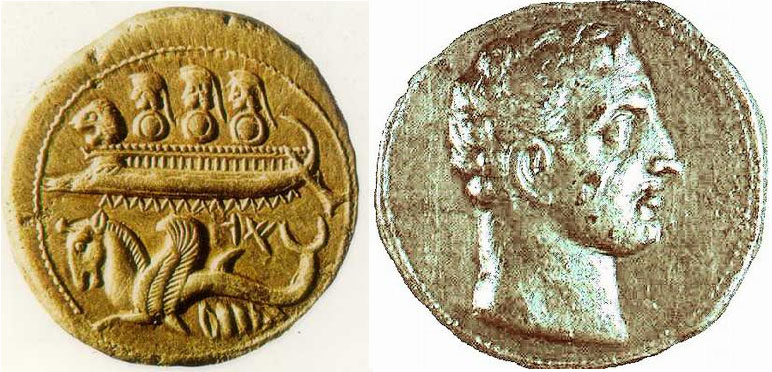
Left: An early Phoenician coin, showing a Phoenician
galley ship. An expert on the subject of Phoenician history and shipwright
advances states: "Nor were these boats tiny. The
galley fighting ships, with their rows of galley oars, could have a crew of
over a hundred people ... But even those were small compared to the Phoenician
cargo ships with their vast, rounded hulls. These ocean-going ships were built
for huge loads and long hauls. They made the extended trips from Mediterranean
ports out to Cadiz, Lixis and other destinations on the Atlantic Ocean coasts
of Spain and Morocco ... People have remarked that those cargo ships which
sailed the seas for many hundreds of years B.C. were comparable in size to
the ones Columbus sailed to America in 1492 A.D. Thor Heyerdahl, the modern-day
explorer, noted that the Phoenicians could have sailed to Central America
themselves ... well-informed people see it as being within the capabilities
of Phoenician ships and navigators." (Sanford Holst,
Cambridge & Boston Press).
Right: One of several coins struck during the Punic (Phoenician) Wars, showing
Hannibal's profile. Each varying coin depicts a consistently remarkable likeness,
although on some Hannibal's image faces the opposite direction.
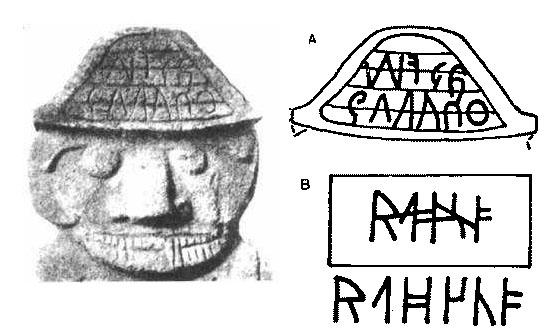 |
In his 1988 article, Corpus des inscriptions
runiques d'Amérique du Sud (Body of Runic Inscriptions of
South America) , Jacques de Mahieu displays photos and provides
commentary about the wide distribution of pre-Columbian, Runic writing
throughout South America (See: Belgian journal Kadath, no.
68, pp. 11 - 42; article about Viking (hyperborean) contacts in South
America.
In the panels opposite are two examples of runes, out of many
found in South America.
(A). Runes on the 'coiffure' of
a statue from San Augustin, Columbia.
(B). Runes found on a Nazca
urn, Peru, followed by their 'normalization' from an abbreviated form
into separated individual letters.
|
There is very clear evidence of Pre-Columbian Runic
writing from the Eastern seaboard of the United States to inland states like
Minnesota and Oklahoma and then to the southernmost countries of South America.
Rather than deal with the extant evidence, Jacques de Mahieu's work has been
"all-too-conveniently" vilified on the basis that he was a Vichy
French collaborator during WWII. The authenticity of the North American runes,
as well as European ogam writing found there, is beyond question and the South
American Runic evidence is also deserving of unbiased scholarly investigation.
In Paraguay alone some sixty-one rock inscriptions have been identified as
Viking Runes (Viking alphabet) by the Runologist Dr. Hermann Munk, who has
stated that the Paraguayan sites are a uniquely important legacy of Viking
culture.
A lengthy Phoenician script was found in a remote area
of Brazil in the 19th century. Amongst many American artefacts found to be
bearing ancient Semitic writing is a large stone dish that was located on
the shores of Lake Titicaca in Bolivia. It is housed at a minor La Paz museum
and is labeled La Fuente Magna (See:
http://www.world-mysteries.com/sar_8.htm )
So many clearly decipherable, ancient Mediterranean-European scripts have
now been located in the Americas, photographed and subjected to expert scrutiny,
that their existence, wide distribution or generally accepted translations
should never be in dispute.
THE HAIR OF THE PERUVIAN MUMMIES
COMPARISONS OF HAIR TYPES
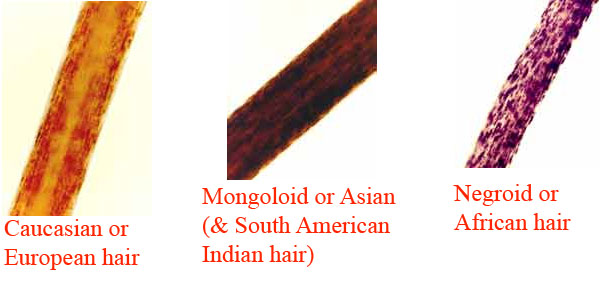
Caucasoid (European)
Hairs of Caucasoid or Caucasian origin can be of fine to medium coarseness,
are generally straight or wavy in appearance, and exhibit colors ranging from
blonde to red to auburn to brown to black. The hair shafts
of Caucasian hairs vary from round to oval in cross section and have fine
to medium-sized, evenly distributed pigment granules.
Mongoloid (Asian & South American Indian)
Hairs of Mongoloid or Asian origin are regularly coarse, straight, and circular
in cross section, with a wider diameter than the hairs of the other
racial groups. The outer layer of the hair, the cuticle, is usually
significantly thicker than the cuticle of Negroid and Caucasian hairs, and
the medulla, or central canal, is continuous and wide. The hair shaft,
or cortex, of Mongoloid hair contains pigment granules that are generally
larger in size than the pigment granules of Caucasian hairs and which
often appear to be grouped in patchy areas within the shaft. Mongoloid hair
can have a characteristic reddish appearance as a product of its pigment.
Negroid (African)
Hairs of Negroid or African origin are regularly curly or kinky,
have a flattened cross section, and can appear curly, wavy, or coiled.
Negroid pigment granules are larger than those found in Mongoloid and Caucasian
hair and are grouped in clumps of different sizes and shapes. The density
of the pigment in the hair shaft may be so great as to make the hair opaque.
A Negroid hair shaft exhibits variation or apparent variation in diameter
because of its flattened nature and the manner in which it lies on the microscope
slide. Twisting of the hair shaft, known as buckling, can be present, and
the hair shaft frequently splits along the length. http://www.fbi.gov/hq/lab/fsc/backissu/july2000/deedric1.htm#Human%20Hairs
Conventional Descriptions of Race
(Coon 1965)
Caucasoid:
Skin fair; eyes pale blue to dark brown; hair straight or wavy; faces/noses
narrow/beaked to broad/snubbed; thin lips; small-medium teeth; little prognathism;
prominent chins; beard/body hair pronounced; relatively long trunk
Mongoloid:
Skin sallow brown/white to brown; eyes brown; hair straight and black; beard/body
hair sparse; high cheekbones; slant eyes (epicanthic fold); shovel-shaped
incisors; flat faces; flat or beaked noses; considerable prognathism; receding
chin
Australoid:
Most archaic; beetling brows; sloping forehead; deep-set eyes; large noses;
large teeth; pronounced prognathism; hair curled to straight; beard/body hair
pronounced; skin sooty near-black to light brown; eyes brown; hair brown (some
blond); long thin arms and legs.
Congoid: (Negroid)
Skin glossy black; eyes black; hair tightly curled; moderate beard/body hair;
bulbous forehead; large nose; thick lips; round head; short trunks/long legs;
buttocks protrude.
Capoid: (Bushmen)
A typical remnants of former major division of mankind; short, infantile looking;
flat faces; yellow-brown skin; wrinkle early; peppercorn hair; medium beard/
sparse body hair; short limbs; small hands and feet; protruding buttocks.
Austroloids come from Australia and its environs and are made
up of people resident in Southeast Asia, as well as Asia or Oceania. They
are classified by their physical characteristics such as dark skin and dark
curly hair. This race is also divided into groups, which include the Australian
Aborigines, the Papuans, the Melanesians, the Negritos of Southeast Asia,
the Veddahs of Sri Lanka, and the Micronesians. The Austroloids have a deep
infraglabellar notch (the notch between the forehead and upper nose), strong
projection of the lower face, and a flat forehead.
Note: There can be wide variations to these generalisations
in physical anthropology, especially in zones where traditional racial stocks
border and blend into each other (i.e.) North Africa or Eastern Europe and
Asia Minor. South American Inca Indians fall under the more general classification
of Mongoloid, as that dominant racial stock has contributed the greater part
of what constitutes the present-day South American (Aztec-Inca-Mayan) Indian
physiology.
*The methods of measuring skulls for the
purpose of determining certain topographical relations, the most important
measurement of the skull being the cranial index, or the cephalic index in
case the measurements are taken on the living. This consists in the ratio
of the width of the head above the ears to the length of the head from the
forehead to the most distant point at the back of the head. The cephalic index
is expressed by multiplying the width of the head by 100 and dividing the
product by the length. Thus, supposing a head to be 153 mm. wide and 186 mm.
long, then 153 × 100/186 = 82.26, the cephalic index. The broader or
rounder a head is, the higher is its cephalic index, and vice versa. When
the cephalic index is above 80 anthropologists term it "brachycephalic";
between 75 and 80, "mesocephalic"; and less than
75, "dolichocephalic."
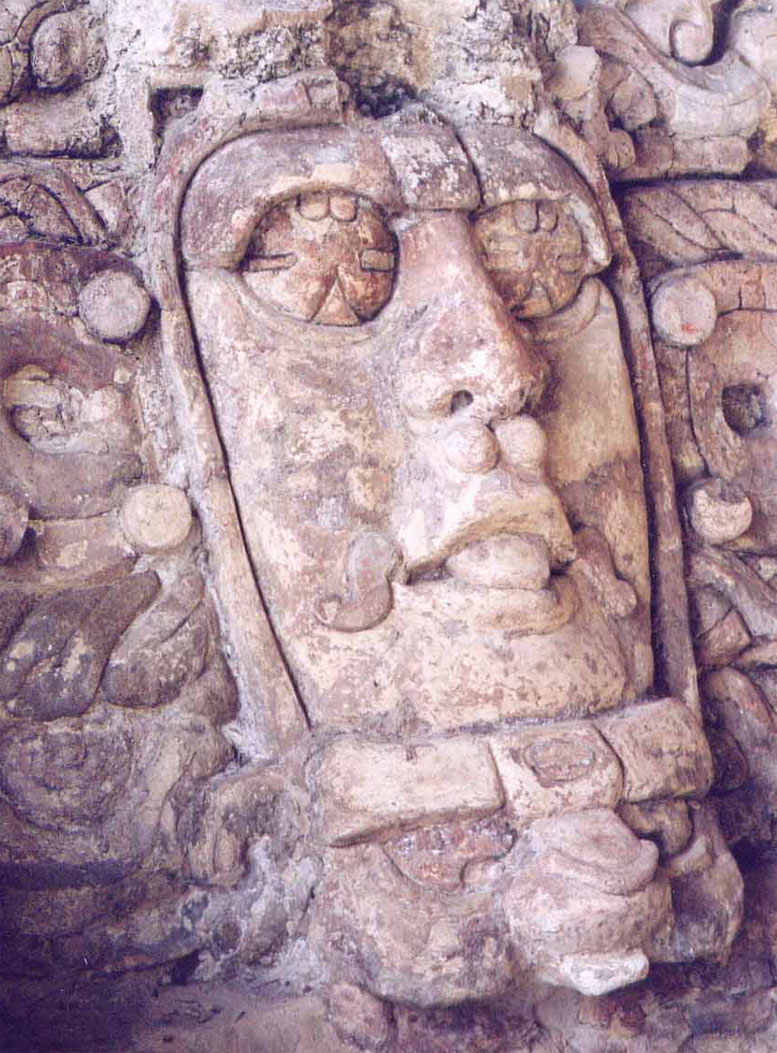
The long thin face and wide round eyes of a European,
peering from his elaborate feather-plume headdress, is carved into this ancient
wall relief at Palenque, Mexico. The faceted design associated with the eyes
denotes the sparkle or glitter effect, commonly found in light coloured eyes
like green or blue. The individual shown also has a prominent moustache, unlike
the present-day Indians who are considered to be beardless. There are thousands
of depictions of these bearded, long-faced people in statues, wall reliefs,
decorative pots, paintings or figurines throughout the Americas. Some South
American artefacts, depicting faces, have bluestone gems inset to indicate
the eyes and their blue colouration. In the above wall relief, the individual's
nose is the leptorrhine (long narrow) type and the crainial shape would be
classified as dolichocephalis, consistent with European physiology and the
physical anthropology of tens of thousands of preserved mummies found throughout
Central & South America.
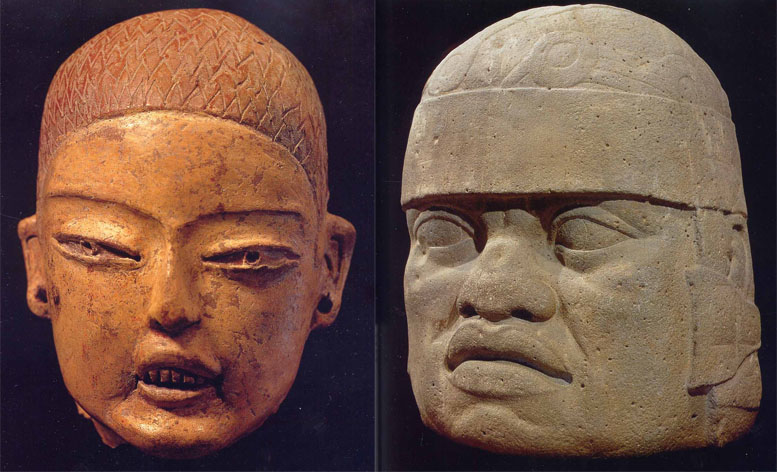
Two ancient artefacts from Mexico that are classified
as Olmec. The facial form to the left is clearly Mongoloid and the facial
form to the right is considered by some to be quite African Negroid. A combination
of all of these physical types, in various admixtures from region to region,
have contributed to the physiology of present-day Indians of North, Middle
and South America. The facial form on the right is quite
typical of a type seen copiously in regions of Polynesia, especially around
Samoa or to a lesser degree, Tonga. Both of these Polynesian / Melanesian
groups, especially the Samoans, also show a high incidence of the distinctively
Mongoloid trait of slanted eyes (epicanthic fold), although the wider-eyed,
broad-head, heavy brow and thick lip individuals,
as depicted on the right, are equally abundant. The head type would be reasonably
consistent with the “Negrito” or oldest Polynesians of the Northern
Hawaiian chain, who displayed traits of brachycephalism
(short head) and platyrrhine noses (broad
and flat-bridged).
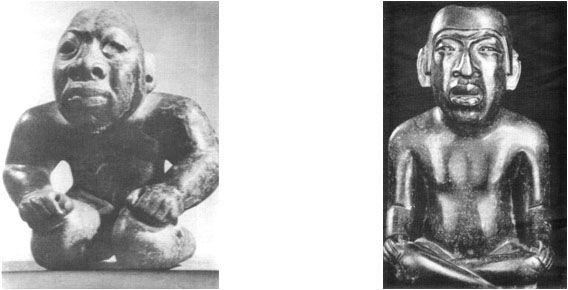
Two more examples of the Olmec physical type, which,
in very generalised terms, appears to be a combination of Pacific Negrito
and Mongoloid physiology, but a radical departure away from the physiology
of the people of the elaborately prepared "mummy bundles", as found
at Nazca, Paracas and elsewhere in Central & South America.
A copious assortment or oral-tradition evidence, physical anthropological
or forensic evidence, artefact and mural evidence, shows us very clearly that
there was a long enduring European Caucasoid civilisation in Peru and many
other Middle or South American countries from remote antiquity. They survived
until recent millennia, when they were overwhelmed and annihilated. The fate
of many, it would seem, was to die as sacrificial offerings on the altars
of their captors. Legends about these white-skinned "Viracochas"
abound in the oral histories of Peru and the Chachapoyas (the cloud people),
who survived in the high, inhospitable country until quite a late era, were
described as tall white people. Fairly recently, 32 of their "quipu"
(khipu) string knot calculation devices were found amongst 200 of their mummies,
recovered from high mountain tombs. To read a 1943 scientific report about
"hair sample" tests done on ancient coastal Peruvian
mummies, CLICK
HERE
SO, WE ARE COMPELLED TO ASK:
ARE THESE THE "MOST STUPID" PHYSICAL ANTHROPOLOGISTS IN THE WORLD
OR ARE THEY JUST "SOCIAL ENGINEERS "POSING AS SCIENTISTS?
Think about it! ... we
are bombarded with TV shows and movies about super-sleuth forensic scientists
who can identify murder victims from nothing more than a bag of bones and
some assorted putrified tissue (CSI: Crime Scene Investigation,
CSI: Miami, CSI: New York, Without A Trace, NCIS, Criminal Minds, Bones, Crossing
Jordan), etc., etc.
These brilliant experts depicted on the "boob-tube",
who understand the physiological differences between ethnicities, can tell
from hair samples, blood-groups and DNA, or particular physical attributes
of the cranium and greater skeleton, who the victim was or even if they were
a mix of several ethnicities. Their profound knowledge and ability to get
to the truth is so intimidating that one misplaced hair, blotch of blood or
slight residue of the murderer's scratched skin under the victim's fingernails
is sufficient to get a murder conviction. No-one wants to mess with the team
at CSI Miami, or CSI New York, or a myriad of other crime scene investigators
and forensic scientists.
But hold on! ... tens
of thousands of perfectly preserved mummies have been exhumed
in Peru and many other South American or Middle American countries,
but their ethnicity remains a totally unsolvable mystery.
It's a case of:
"All the kings horses and all the kings men couldn't put Humpty together
again". Apparently, the brightest
and the best in our scientific community are absolutely
stumped by these anomalous, mummified humans, who might
as well be two-headed, scaly-skinned reptilians from Draco - so mystifying
and indefinable is their physiology, never seen on Earth before...
Our experts can figure out the diet of the mummified people
by food-stuffs in the stomach, the cause of death in many cases, the age of
the deceased at the time of death, the diseases that they had (even syphilis
and tuberculosis from long before the Spanish conquest), but despite being
presented with large samples of blond, red, auburn, brown or darker hues of
thin diameter European hair and accompanying tissue, or full European skeletal
and craniology features, still can't figure out which ethnic group these people
belonged to. This must rate as the biggest "hush-hush unmentionable"
in modern-day archaeological and anthropological cover-ups. The whole socially-engineered
sham is an insult to human intelligence. Either the "experts" are
a pack of imbeciles, or they think we are.
-
When presented with the fact that the hair is multi-coloured
, the experts say: ...
Oh!.... well
it must have changed from Inca black to blond or red or auburn or chestnut
brown or dark brown or stayed black due to the effects of sunlight
(there was no sunlight, as the bodies were in bags under layers of cloth
and then either buried, placed in deep chambers or in caves that were utterly
dark). From other evidence around the world, mummy hair does not undergo
any significant change in pigmentation during millenniums of interment in
conditions where there is no light. This fact was substantiated by anthropologist,
Mildred Trotter in her letter (June 22nd 1951) to Dr. Thor Heyerdahl. To
see Heyerdahl's summary,
CLICK
HERE
- When presented with the evidence that the hair is very thin and
of a consistency only found in European hair, the experts say: ...
Oh! ...well the hair must've shrunk (over 30%)
in thickness during the long period of interment.
From other evidence around the world, mummy hair does not change its cross-sectional
dimensions in any known or significant way, but only becomes very brittle
with age. This fact was substantiated by anthropologist, Mildred Trotter in
her letter (June 22nd 1951) to Dr. Thor Heyerdahl.
- When presented with the evidence that the skull types (cranial indexes)
are the longer face, dolichocephalic form, consistent
with European-Caucasoid physiology, the experts say:
...Oh! ... well these must all be "bound"
skulls that were deliberately distorted and elongated in the formative years.
This explanation had to be proffered to explain why Inca Indian skulls (Paracas-Nazca
region) are brachycephalic in form and utterly different to the physiology
of these ancient mummies (dolichocephalic form).
Although a few skulls of the region were artificially
distorted by binding in this way, the vast majority were not and, moreover,
it's only possible to change the shape of the top section of the cranium by
infantile pressure-binding. The rest of the face and mandible develop normally
and retain their ethnic physiological features or attributes.
- When presented with the evidence that the Paracas or Nazca mummies
were of considerably taller people than the stature of Inca Indians, the experts
say: ... Oh!... well the ancient people
must've only mummified the tallest people in their communities and the average
or short stature people were not accorded this honour.
- When presented with evidence, based upon tissue
samples taken directly from the Paracas and Nazca (and other) South American
mummies that indicates the presence of A, B. AB and 0 blood groups in America
prior to known European contact ...
This only suggests the need for a revision of concepts of blood groups in
the American Indian.
In an "academically-muted" forensic study titled, ABO
Blood Groups in Peruvian Mummies it states: 'The above
findings have not gained general acceptance except
where all are found to be group 0. The presence of groups other
than this have been considered artefacts
by many investigators [the Incas of Peru are 92% group O].
In 1959, Boyd in a short review wrote “The absence of B in American
Indians is in many ways the most surprising thing about them,” yet in
1937 he had found six B and two AB mummies in his own study. One B and one
AB in his studies belonged to the Paracas culture'.
(See: ABO blood groups in Peruvian mummies: An evaluation of techniques,
by Marvin J. Allison, Ali A. Hossaini, Nora Castro, Juan Munizaga, Alejandro
Pezzia. In association with Department of Pathology, Medical College of Virginia,
Health Sciences Division, Virginia Commonwealth University, Richmond, Virginia
Department of Anthropology, University of Chile, Santiago de Chile, Museo
Regional de Ica, Ica, Peru.
Also citing: Correspondence to Marvin J. Allison, Professor of Clinical Pathology,
Medical College of Virginia, Richmond, Virginia. Supported by a grant from
the National Geographic Society*).
'In one series of tests by William C & Lyall G Boyd (circa
1930's) 300 mummies of both American and Egyptian origin were subjected to
blood grouping tests, by the absorption-technique. In several samples a specific
absorptive power indicated the presence of A and B. Such results were obtained
with certain Basket Maker and Peruvian mummies, and in particular, among the
Egyptians, A and B seem to be present in certain predynastic mummies more
than 5,000 years old'.
* Footnote: It's of interest to note that the forensics study
to positively identify the blood groups of the Peruvian mummies, involving
5 major institutions, was funded by The National
Geographic Society, The Society released a documentary in
2002 dedicated to the exhumation and study of formerly undisturbed mummy bundles.
Despite the above study and the revelations concerning European blood groups
in the mummy physiology, no statements to this effect were made in the documentary.
To the contrary, the camera would pan in on an ornate mummy bundle and its
contents, then immediately pan to a modern-day Inca, as if to cement in the
mind of the viewer a direct association between the two and leave the impression
that the mummified individuals were just ancient Incas (See: Inca
Mummies - Secrets of a Lost World, National Geographics documentary video,
2002).
The tactic became oppressive and somewhat nauseating, as if it was of tremendous
importance to some social-engineer to impress this delusional "fact-by-association"
subliminally upon the mind of the viewer. Some further illogical and "dirty-pool"
tricks were used as well. To explain:
A large part of the documentary was focused on a "race against
time" to exhume mummies beneath a schoolyard in a shantytown
called Tupac Amaru that had sprung up near Lima Peru. The top layer of mummies,
buried within a few feet of the school yard surface, were found to be crushed
and ruined due to the activities and weight of the bulldozer, which had originally
leveled out the schoolyard. Some scant information was retrievable from these
crushed mummies and it was very apparent that the variable hair samples seen
were considerably lighter than anything seen on the modern day Incas, which
the camera was constantly seeking out.
- Later the excavation went much deeper and exposed pristine mummy bundles
that had been unaffected by the ponderous lumberings of the less-than-subtle
bulldozer above. A large number of these bundles, some huge and containing
up to five bodies in one bundle, were carefully removed and taken away for
controlled opening at the lab.
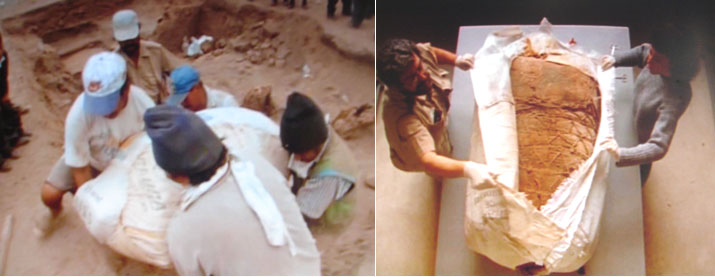
A mummy bundle, carefully enshrouded within a protective plastic bag
by the archaeologists, is removed for transportation to the lab. At the lab
the protective plastic is removed and the mummy bundle itself then carefully
opened to expose its amazing historical content, the true significance of which
is kept secret from the public.
Now the propaganda began in earnest. A huge, perfectly intact mummy bag was
carefully opened before the cameras and the artefacts of a seemingly wealthy
group of weavers (as evidenced by the artefacts included), enjoying an abundant
lifestyle, was exposed to the expectant world. This "bundle of joy",
it was inferred, was obviously from the utopian civilisation that preceded the
evil and dreaded Conquistadors. After this very positive and moving interlude,
a second mummy bundle was opened before the camera. Oh bugger! This bundle contained
a mother and child, and the jaw of the child, as well as other regions of the
skull, showed distinct porosity of the bone, impelling the resident anthropologist
to comment soberly that this was 'a very sick child'.
The ensuing, "politically-convenient" logic went something
like this:
Inasmuch as the poor infant, of tender age, had
succumbed to disease, and even though this second perfectly
intact bundle had been found deep down in the same approximate strata or level
as the earlier "bundle of joy", it was stated this one must've been
interred just after the [filthy, disease-ridden] Spanish
arrived and the drawn-conclusion was that the child had contracted
a European disease from the Conquistadors. What followed was a lengthy diatribe
on how "paradise" had been reduced to "hades" by the arrival
of the filthy Spanish.
Although this researcher doesn't really want to "rain on anyone's parade",
perhaps a few questions are in order.
- Why was there no mention of the facts that these mummified people have very
different, lighter hues of thin diameter European-type hair; are
considerably taller; have a different cranial index and European blood groups,
un-typical or almost never found in the Incas, unless they have some European
ancestry?
- What compelling proof is there that this burial was, strangely, from the
"Spanish" epoch? Does that make any sense, when layers of bundles
above had been unceremoniously crushed by a bulldozer and this intact, albeit
sickly, bundle was, logically, contemporaneous to the "bundle of joy"?
- Do the female anthropologists working and commenting during the documentary
know how to recognise and identify the differing elements of ethnic physiology?
Have any of them read Mildred Trotter's 1943 report titled, Hair
from Paracas Indian mummies, Volume 1, Issue 1 , Pages 69 - 75 of American
Journal of Physical Anthropology and Trotter's later, updated findings?
Have they read the detailed reports about the blood grouping of the mummies
and how they differ markedly from known Inca blood types?
- The formerly dignified sciences of archaeology and anthropology seem to
have been largely hijacked by censors and reduced to something akin to kindergarten-level
propaganda. There are now huge "sins of omission" and condescending
presentations that have a pronounced "Ronald McDonald" PlastiC
Portrayal or "Sesame Street" science flavour to them. The brainwashing
content carefully steers the viewer towards "approved conclusions",
indelibly impressed by constant reinforcement. An example would be:
In the National Geographics documentary, the central archaeologist-anthropologist,
"Willy", is shown standing in a severely dug over piece of denuded
terrain that looks like a "moonscape" where there has been wanton
destruction of the mummies by "treasure seekers" digging them up
and plundering their goods. The commentary covering this deplorable activity
states: 'The plundering that was started
by the Conquistadors nearly 500-years ago has plagued Peru ever since'
... reinforcing the concept (over and over) that it's all the fault of the
Conquistadors and the present-day plundering (or any other ill that besets
Peruvian society today) is the fault of the Conquistadors (agreed, they weren't
particularly nice and I wouldn't want my sister to marry one). Watching some
of these documentaries is like watching an infomercial or heavily biased,
buck-passing, political diatribe.
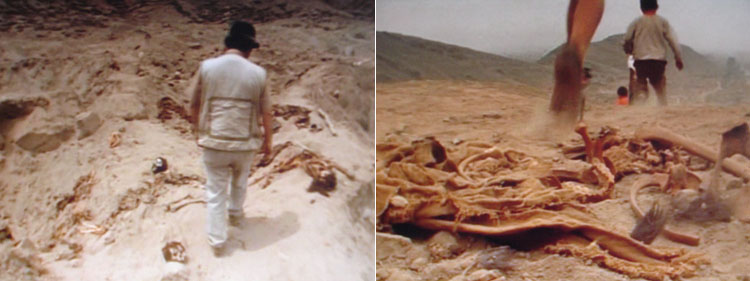
Archaeologist-anthropologist "Willy" surveys
the "moonscape" where grave robbers have turned the terrain upside
down. He saunters past a red-headed skull that has been unceremoniously cast
aside by the treasure seekers and observes other strewn remains scattered about.
In the picture to the right, children run, jump over and play amongst the picked-over
remains of the ancient Peruvian high civilisation. The utter contempt and lack
of respect shown demonstrates that many modern day Peruvians feel no family
or cultural affiliation to these very foreign human remains of enemies that
their forebears conquered long before the arrival of the Spanish Conquistadors.

The gagged physical anthropologist to the left places
reddish coloured, Peruvian mummy hair into a test tube for analysis (not that
the general public will ever get to see the results). The physical anthropologist
to the right examines the pitted and porous skull of a 3-year old infant and
her prognosis is that the child has succumbed to disease and malnutrition. As
a consequence, the only logical conclusion drawn is that this must be a burial
from after the filthy, disease ridden Spanish arrived...how else would the child
have gone hungry and become sick??? According to the "stave-off" commentary,
identifying the physical anthropology of these tens of thousands of well preserved
mummies. 'is going to be a very long term study. It's
going to take five, six, eight years'. Strange that! ... Mildred Trotter
(centre) and her colleagues had undertaken analysis on Peruvian mummies over
60-years ago and positively shown from the results obtained that the specimens
studied fitted the profile of ethnic Europeans.
The scientific work has been done, but is mostly inaccessible
to the public, except through very deep and expensive digging into rare scientific
journals & periodicals. The results are understood and clear at some high
level of the scientific community, but there will be no "trickle-down"
of the salient facts, as they don't quite fit someone's political agenda. The
dumbed-down, shifting herd must never be privy to this information, lest they
gain a grasp on true history.... Ad nauseam, ad infinitum.....
We get the message loud and clear ...
ancient Europeans aren't allowed to be in Central
& South America and any great works they did there have to be given away
to an altogether different ethnicity ... the academic community must remain
vigilant and ever watchful to keep inconvenient "unmentionable-facts"
under-wraps and out of sight or the greater public ... yet another UNESCO-promoted,
PC establishment case of "erase all trace of the
European race".
Who is in control of the dissemination of South American
archaeological, physical anthropological and forensic evidence? It appears obvious
that the authorities in Central and South America are pulling the same stunt
as the authorities in New Zealand on the opposite end of the Pacific Ocean,
regarding evidence of the oldest civilisations in their midst. All the Peruvian
authorities have to do, along with their "in tow", overly-accomodating,
moral-coward scientists, who misrepresent themselves as physical-anthropologists,
is to call all mummies found pseudo-Incas or "Incas".
The cover-up logic goes something like this:
Heck!, the Inca people of today are a mix of a lot of groups and there are sure
to be a few bloodlines that go back to some of these "trussed-up",
mummified ancient-Gringos, which would make some of them ancestors..., right?
...so let's just call the people found in the mummy-bags "Incas" by
association or "Incas-forebears". Heck!, it doesn't matter a damn
if those people were from a far more ancient time-frame and, in a physiological
sense, were a completely different ethnicity, with no anthropological resemblance
to the Incas of today. It doesn't matter that they were besieged at some late
epoch by opportunist interloper invaders, slaughtered, enslaved or sacrificed
on Olmec-Aztec-Inca or whoever's altars. Hell!, it doesn't matter that enslaved
enemy women were forced to have babies, fathered by their conquerors without
consent.
We'll just refer to all of these enslaved, demoralised
people as "beloved ancestors" and, by virtue of "the
spoils of conquest", claim any and all work they did or cultural
expressions that they possessed as simply an older expression of the latter.
As long as we keep all of the terms of reference very non-specific and unclear,
then we can so-classify the ancient people with murky scholastic impunity and
our use of such a broad, meaningless, non-threatening generalisation won't lead
to career-suicide ... Lord forbid that that should happen!
In keeping with Unesco, United Nations, the International
Labour Organization and the World Bank promotional policies towards "indigenous
people", we'll discount as "unreliable" the
oral traditions passed down by the Inca, Aztec or Mayan elders and sages, where
copious reference is made to the white-skinned people who preceded them. We'll
just relegate to the "mythological" all references
concerning the many white and bearded Viracohas mentioned from
region to region (Quetzalcoatl, Itzamnacanil, Kukulcan, Votan, Condoy,
Vestiges, Bochita, Zume), etc., as if they didn't really exist
and never really take these inconvenient histories seriously. Instead, we'll
take a paternalistic, condescending and limited approach to the subject, which
nullifies most of the facts or detours attention away from them, but strokes
the egos of modern-day "indigenous people", by continued positive-reinforcement
that 'you and your related ancestors (including your Nazca forebears)
did all of this'.
Despite the fact that impressive archaeological ruins
and architectural wonders, like those at Caral, Peru, along with their quippu
artefacts, etc., are at least 5000-years old or that sites at Chilica and Paracas
date to 6000 BC, we'll gloss over all that and not dwell too heavily on "who
did exactly what" over the course of millennia. Instead, we'll juggle things
around and move time frames forward as much as possible to better lay claim
to the huge temple-pyramid complexes and 14-thousand miles of stone paved Peruvian
roads or mountain traversing trackways, agricultural terraces laboriously built
in inhospitable mountain terrain, huge irrigation networks, mummies, pottery,
textiles, artefacts, cultural expressions and symbolism, with all highly developed
accomplishments of the earlier great civilisations being more-or-less extinguished
or nullified by transfer to their conquerors. We'll then strongly infer in our
Ronald McDonald, PlastiC
documentaries that all of these great works can be attributed to the Incas,
within the rushed timeframe of less than 100-years commencing in about 1438
AD. There'll be a few vague, disarming references to Nazcans and others, (circa
100 BC through to 700 AD), but the main thrust of the exercise will be to leave
the impression that latecomer Incas, by pedigree-association or otherwise, "did
all of this".
Amongst the social-engineers, seen to be fudging Nazca
history, is Anthony F. Aveni, the much lauded and applauded
Russell B. Colgate University Professor of Astronomy and Anthropology,
who states rather slyly in his book, Between The Lines:
 |
'Despite the fact that
the line builders preceded the Incas by a thousand years, Nasca ideas
about how to configure the pampa seemed to us to relate in a subtle way
to Inca concepts of construction. The ideologies of these two cultures,
though spread wide apart in space and time, may have been closer than
we thought. Here was a continuation of ethnic identity of Native American
people transcending more than a millennium.' (See
Between the Lines pg. 4).
Well Anthony, as a so-called "Anthropologist",
perhaps you could deal with the very obvious physical-anthropological
differences between the "dolichocephalic-Caucasoid"
mummified people who actually built
the lines, as well as the Cahuachi pyramid complex, etc., and the much
later "brachycephalic-Mongoloid
Incas. Such an obvious and fundamental beginning
point, as a precursor to valid scientific investigation, seems to have
escaped your attention for some incomprehensible reason!
In the above statements by Aveni, a hypothesis proffered in one sentence
graduates into a definitive concluson by the next sentence. The reader
is, thereafter, "thrown off the scent",
detoured away from factual scientific information and led off into a politically-expedient
fantasy land early in Aveni's book.
|
We'll then blame the "gold-lusting" Spanish
Conquistadors. on the disruption of the empire to explain why the magnificence
of yesteryear fell into permanent ruination The truth is that the latter-day
Incas, Aztecs or Mayas could never emulate the advanced level of civilisation
or breathtaking accomplishments of the earlier epoch, which predated them by
thousands of years. We'll also state that the filthy, microbe-ridden Conquistadors
brought the first of the exterminating diseases to the formerly sanitised and
hygienic, disease-free, isolated region, thus wiping out the Aztec, Incan or
whoever's civilisations by plagues. We won't mention that our anthropological
probes have proven that many of the the same diseases were in residence long
before the Conquistadors ever arrived and that there had been long-term contact
with other continents (and their diseases) for millenniums before the Spanish
conquest. We'll also omit to mention that the tiny groups of Spanish "conquerors"
formed strong alliances with Indian tribes who hated the bloodthirsty, Aztec
or Inca leadership and were only too happy to provide warriors-allies to overthrow
these oppressive regimes.
In short, outsider social-engineers, with political agendas
dictated by UNESCO, have hijacked Peruvian archaeology or the physical-anthropology
of its ancient people and only let a few minor, sanitised and tailored facts
come out, while the major truths cannot get past the PC filters... Ad
nauseam, ad infinitum ...
As for the lines at Nazca, Dr. Hans Horkeimer, of Trujillo University,
Peru observed in 1946 that, 'few of the modern residents knew anything
about the lines and many did not realise they existed'. Despite this,
Indian people, marching in solemn, single-line procession, now walk the lines
before TV cameras while dressed in traditional costumes and playing flutes
or beating drums. The somber, dignified parade is represented as an ages-old
religious ritual, constantly observed since ancient times. This newly concocted
role-play seems geared more towards satisfying the hypothetical fantasies
of modern-day archaeologists, social-engineers and documentary makers than
any traditional appeasing of old Inca gods.
What we desperately need is legitimate and unbiased "physical
anthropologists" who will tell us the truth about the physiology and
ethnic origins of ancient Nazcans. We've had more than enough of "cultural-anthropologists"
or "humanist-anthropologists" or "social-anthropologists",
who are well trained in the art of substituting real history for nonsensical,
PC dribble.
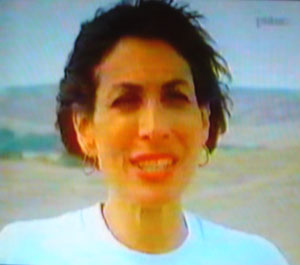 |
Social anthropologist, Helaine Silverman states,
in touchy-feely, maternalistic fashion:
'If we look at Nazca pottery; if
we look at the textiles; if we look at the Pyramids at Cahuachi we see
that all of the technology necessary for making the Nazca lines, the
geoglyphs on the Pampa, were present in Andean society. So why do we
have to look to more advanced societies, be they extra-terrestrials
or ancient Egyptians? People with that kind of attitude are appropriating
the achievements of Andean people and they're denying the cultural creativity
that so manifests in this country'.
Well Helaine, instead of heart-tugging appeals for reason or
"guilt-loading" heaped onto anyone who dares to look dispassionately
at the full body of scientific evidence, why not provide us with real,
"warts-'n-all" facts. All you've succeeded in doing so far
is to make multiples of misattributions,
based solely upon the requirements of the PC establishment. Stop wasting
our time with banal, emotive nonsense and propaganda! |
Silverman speaks in gushy adoration of her colleague
Anthony Aveni in a reciprocal arrangement of two-way adulation. Silverman
reviewed Aveni's year-2000 book and he describes Helaine Silverman as: "particularly
instrumental in influencing the course of our research after 1982.'
With social-engineers like this hogging and controlling the flow of information
from Nazca, there seems to be little hope of advancing true scholarship related
to the region in the foreseeable future.
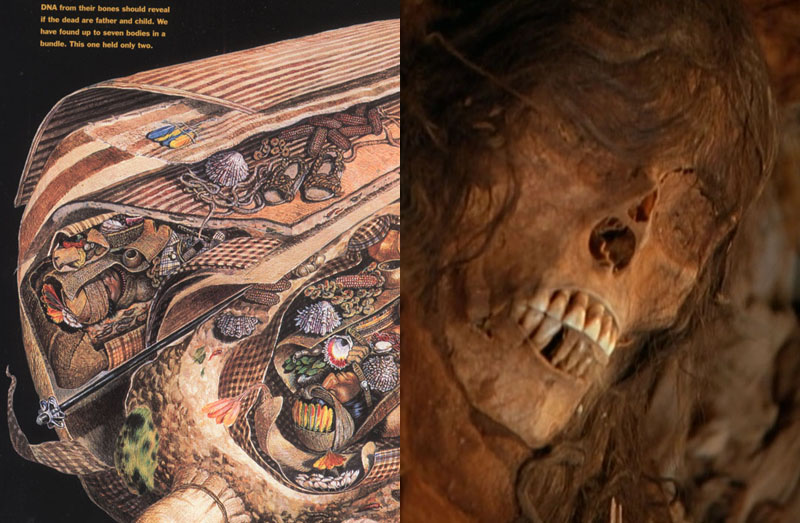
In the May 2002 issue of National Geographic Magazine
a large centrefold illustration shows a cutaway view of the contents of a
typical mummy bundle from Tupac Amaru (left). Although all of the mummies
appearing in the documentary were individuals with lighter hues of wavy thin
hair and distinctly Caucasoid European physiology, the magazine illustration
(above left) depicts a deceased individual with distinctly Inca Indian facial
physiology and jet black hair. What should have been represented is the European
physical type, like that of a woman shown above to the right, with a very
triangular nose opening, prominent chin and thin, wavy, chestnut brown hair*.
Furthermore, a caption on the National Geographic illustration reads: 'DNA
from their bones should reveal if the dead are father and child ...'
The truth of the matter goes much deeper, as the whole package of DNA, blood
groups, hair type and physical-anthropological analysis would reveal that
these mummy-bundle people were (predominently if not exclusively) Caucasoid
Europeans with root origins in the Mediterranean and Continental Europe. We
can safely assume, however, that there will never be any public announcement
of this very unwelcome scientific fact and that we'll continue to be fed only
Inca-aggrandising propaganda as a substitute for true history.
*Footnote: Heyerdahl writes: "Before I was kindly
furnished with this interesting information by Trotter, the British Museum
had suggested W. R. Dawson as a leading British authority to consult on
the question of possible change in mummy hair. Dawson (1928, p. 127)
who is earlier quoted as examining on the Pacific coast of North Chile an
embalmed adult woman with "abundant light-brown
hair", was kind enough to send me his opinion as follows:
"From the examination of
a large number of mummies both from Egypt and other countries including South
America, my opinion is that hair does not undergo any
marked change post-mortem. The hair of a wavy or curly individual remains
curly or wavy, and that of a straight-haired person remains straight. In mummies
and desiccated bodies the hair has a tendency to be crisp and brittle, but
this is the natural result of the drying-up of the selacetes glands, which
during life, feed fatty matter into the hairfollicles which keeps the hair
supple and flexible ... it seems to me very unlikely
that any change in colour would take place in a body which had never been
exposed to the light, ...To sum up then, all the evidence I have indicates
that the nature of hair does not alter after death
except in becoming dry and brittle."
For evidence of longterm Caucasoid-European presence
in the Americas see: http://podblanc.com/index.php?q=node/14093
So, despite the politically-expedient limitations imposed by
our politically-aligned experts, now that we know that the early inhabitants
who lived contemporaneously to the line-making were ethnic European-Caucasoids,
we can test the geometry of Nazca using age-old
European distance and angle standards. These very well-known
measurement systems, shared by all the cousin European nations, were very
prevalent during the Neolithic Age of Great Britain, but stem from further
back in time to the many Eastern Mediterranean countries where European forebears
once lived, extending yet further afield to Northern India and the Tarin Basin.
Continue












